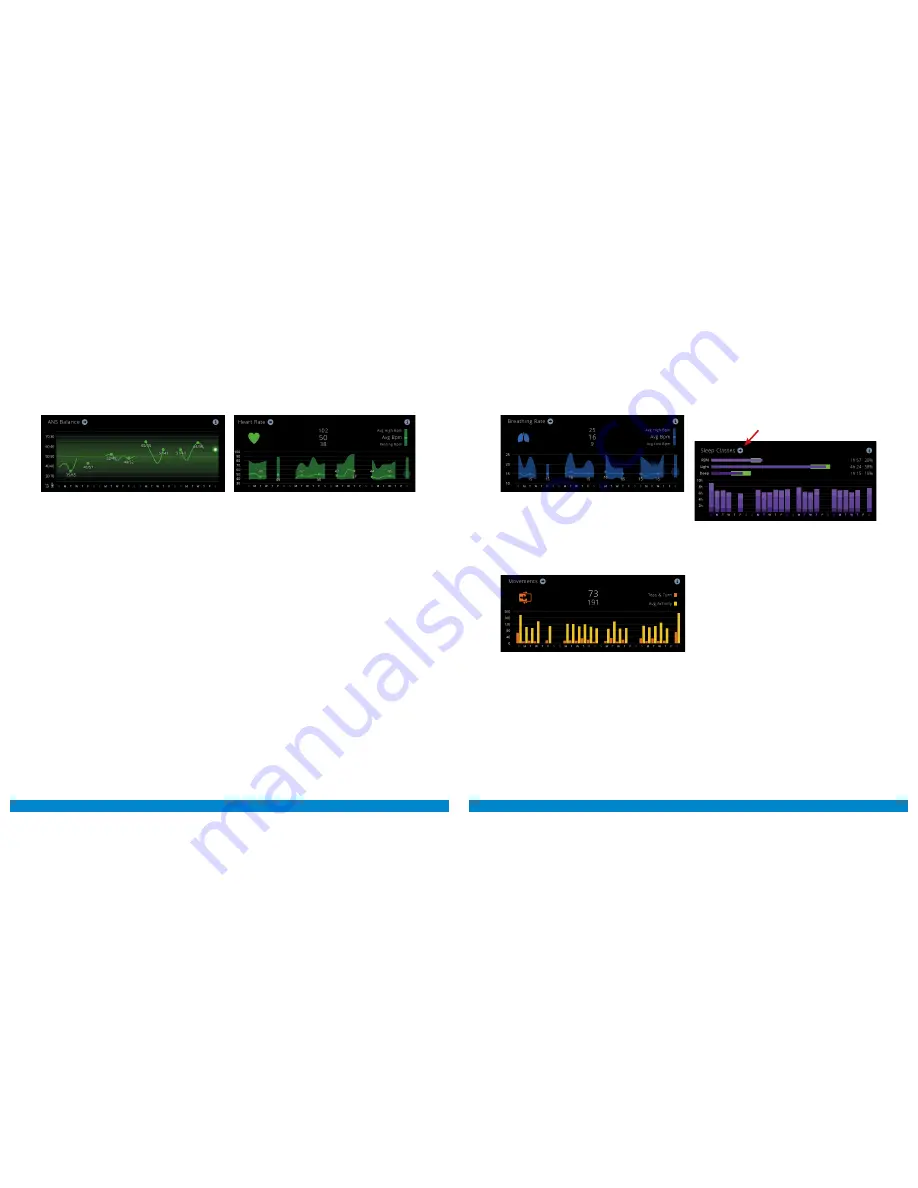
36
37
7. ANS BALANCE
Autonomic Nervous System Balance tells whether
the user is too excited (high LF value) or too phleg-
matic (high HF value).
LF and HF refer to Low Frequency and High Frequency,
respectively, and they both are common frequency do-
main measures of heart rate variability.
LF is the area measured in a frequency band of 0.04-
0.15 Hz, and it is considered as a state indicator of both
sympathetic/parasympathetic nervous systems.
HF is the area measured in a frequency band of 0.15-
0.4 Hz, and it is considered as a state indicator of par-
asympathetic nervous systems.
In our system we use normalized units LFn and HFn,
and the normalized units have been expressed as a
percentage of the sum of LF+HF, i.e. LFn=LF/(LF+HF).
Diagram displays both LFn and HFn, and ideally, the
indicator should stay near the 50-50 shaded line be-
tween values of 25 and 75.
Deviation beyond 25-75 or 75-25 line may be indica-
tion of insufficient recovery, high or chronic stress, gen-
eral fatigue or some other malfunction in your body.
8. HEART RATE
Avg BPM is simply average heart rate for the whole
night.
To find the Resting BPM, your average heart rate is
computed for every three-minute time window during
the whole night, and the smallest value is chosen out
of all these. In other words, it is the smallest 3-minute
average heart rate you had during sleep.
Resting BPM can be used as a mild indication of
stress or overtraining. After you have established
your baseline Resting BPM during a couple of
weeks, you can check out for notable deviations
from this norm.
General rule of thumb is that if your Resting BPM
bumps up more than 7 beats per minute, you should
consider skipping the exercise or exercise little bit
lighter, and find some means to relieve your stress. The
same rule applies also if there is a notable decrement
in Resting BPM value.
Rapid changes in Resting BPM should not be confused
with long-term changes. For example, physical exer-
cise tends to decrease resting heart rate over time, and
this only tells that you are getting more fit!
9. BREATHING RATE
Avg BPM is simply average respiration rate for the
whole night.
The typical respiratory rate for a
healthy adult at rest is 12–20 breaths per minute.
Respiration rates may increase with medical condi-
tions, such as fever or illness, and rise in Avg BPM may
indicate this condition.
10. MOVEMENTS
Avg Activity measures larger movements than
those caused by heart beating and respiration,
such as twitching leg or arm or changing position
only slightly.
Bigger movements of your body are indicated by
number Toss & Turn.
Higher value both in Avg Activity and Toss & Turn might
indicate restless night, and these should be inspected
against your own baseline values. Long term increase
in these numbers may be indication of approaching
over training condition.
12.2. More detailed information acces-
sible through arrow button or tabs
• Sleep Classes
. Shows sleep architecture and bed
exits. From this figure the user can see how different
sleep classes are distributed throughout the night.
Usually deep sleep phases should occur in 90-120
minute cycles, 4-6 times during the night. Alcohol or
drug use, heavy trainiing, or stress may change the
pattern.
•
Heart Rate / Respiration Rate.
This figure helps to
see when and how deep person’s heart and respira-
tion rate gets. Healthy individual should see clear pat-
tern where heart rate goes down as sleep deepens,
and goes up in light sleep and REM sleep.
• Activity / Turns.
Gives indication how restless sleep
has been. If there is lots of activity and turns, sleep
quality is probably poor too.
• Nervous System Balance.
This should remain gen-
erally near 50 %. If it peaks often over 25/75 % line, or
it leans continuously to other side, one should consid-
er relaxing (in case of high LF) or stimulating (in case
of high HF) himself a little bit.
Содержание QS
Страница 24: ...Notes ...





















